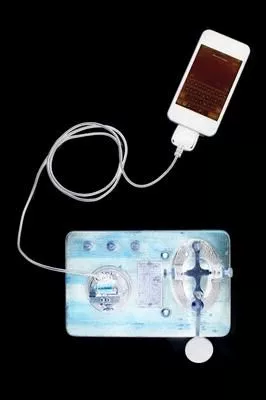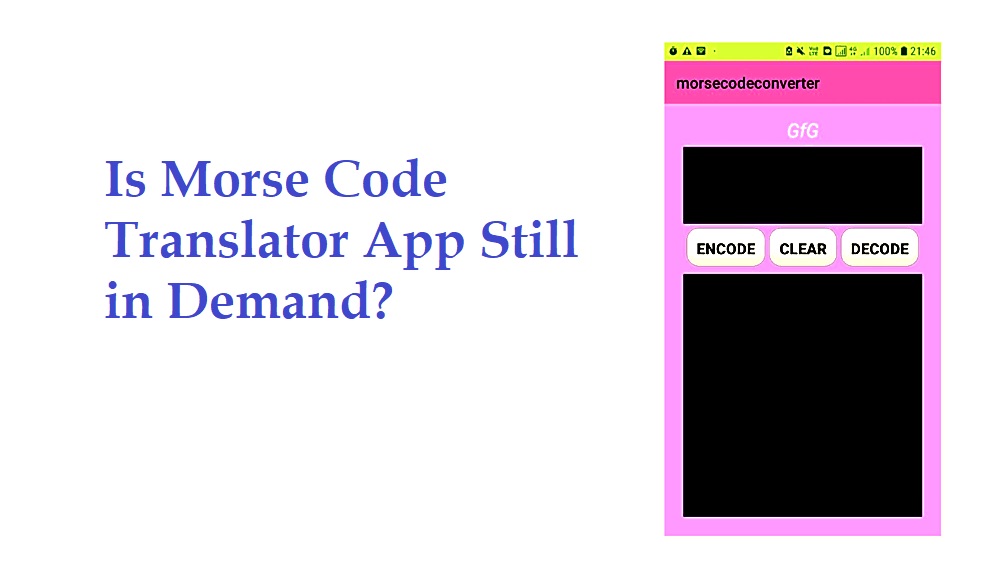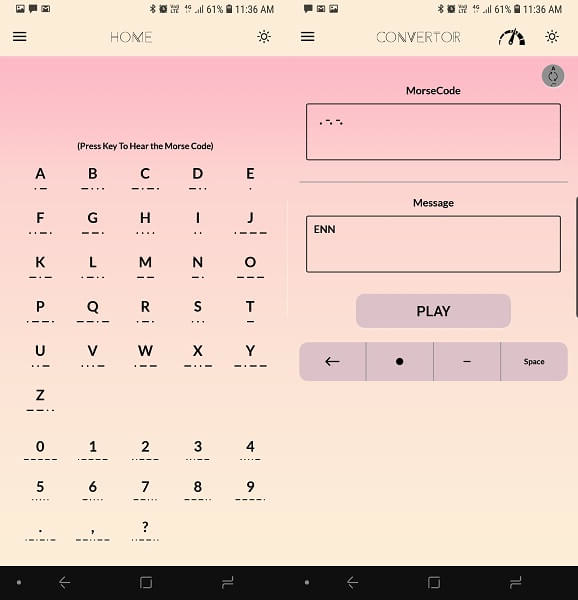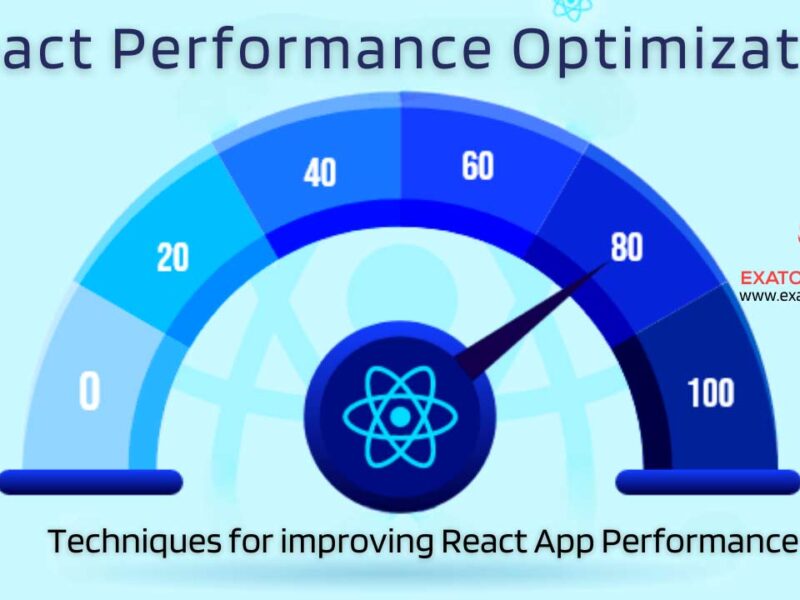Morse code is a method of transmitting text information as sequences of two different signal durations, commonly referred to as dots and dashes. Developing a Morse code translator mobile app can be a great project for beginners to intermediate-level mobile developers. The app can be used to translate text messages into Morse code and vice versa, making it a useful tool for amateur radio enthusiasts and people interested in learning about the history of communication technology. To get started, you will need to have basic knowledge of programming languages such as Java or Swift and have access to a development environment such as Android Studio or Xcode. In this guide, you will learn the steps to develop a Morse code translator app for Android or iOS platforms.
What Is International Morse Code
International Morse code is a standardized system of representing letters, numbers, punctuation, and procedural signals as sequences of two different signal durations commonly referred to as dots and dashes. It was initially developed for telegraph communication, but it has since been used in various forms of communication, such as radio and teleprinter.
The code has been standardized internationally and is widely used in amateur radio communication and as a means of teaching communication skills in many countries. Each letter, number, punctuation, and procedural signal has a unique sequence of dots and dashes in International Morse code, making it possible to transmit text information efficiently and accurately.
What Is Morse Code Translator Mobile App?
A Morse code translator mobile app is a software application designed for mobile devices such as smartphones or tablets that can translate text messages into Morse code and vice versa. The app typically has a user interface that allows users to type or input text, and then translate it into Morse code using dots and dashes, or vice versa.
The app may also have additional features such as the ability to play audio of the Morse code, or to display the translation in a visual format, such as flashing lights or on-screen dots and dashes. The purpose of a Morse code translator mobile app is to provide a convenient and accessible tool for learning about Morse code, for amateur radio enthusiasts, or for anyone who wants to communicate using this historical form of technology.
How to Develop Morse Code Translator Mobile App?

Here are the general steps to develop a Morse code translator mobile app:
1. Plan your app:
Step 1, “Plan your app”, refers to the initial stage of development where you decide on the features and design of your Morse code translator mobile app. This involves determining the functionality you want to include in your app, such as text-to-Morse code conversion, Morse code-to-text conversion, audio playback of the Morse code, and any other additional features you may want to include.
It also involves deciding on the user interface design, such as the layout and appearance of the app, and how users will interact with the app to input text, display the translation, and access other features. This stage is crucial as it sets the foundation for the rest of the development process and helps you define the scope of the project.
By planning your app, you can create a clear roadmap for the development process, ensuring that you have a clear understanding of what you want to achieve, and can prioritize tasks accordingly.
2. Choose a programming language:
Step 2, “Choose a programming language“, refers to the decision of which programming language you will use to develop your Morse code translator mobile app. The programming language you choose will depend on the platform you have chosen for your app, as well as your own personal skills and experience.
For Android, Java is a popular choice of programming language, while for iOS, Swift is often used. It is important to choose a programming language that you are familiar with, as this will make the development process faster and smoother.
Additionally, it is also important to consider the resources available for the programming language you choose, such as tutorials, forums, and libraries, as this will make it easier to find help and support when you need it. By choosing the right programming language, you can ensure that your app is developed efficiently and effectively, and meets your requirements.
3. Set up a development environment:
Step 3, “Set up a development environment”, refers to the process of installing and configuring the necessary tools to develop your Morse code translator mobile app. This includes downloading and installing a development environment such as Android Studio for Android or Xcode for iOS, as well as any other required software, such as a source code editor or a debugger.
Having a proper development environment is crucial for efficient app development, as it provides you with the necessary tools to write, test, and debug your code. It also allows you to easily manage the different components of your app, such as the user interface and the code that powers the app’s functionality.
In addition to installing the development environment, you may also need to install any necessary libraries or frameworks, as well as configure any necessary settings, such as your development environment’s preferences or settings. By setting up a development environment, you can create a dedicated space to work on your app and ensure that you have everything you need to get started with the development process.
4. Define the user interface:
Step 4, “Define the user interface”, refers to the process of creating the visual layout and design of your Morse code translator mobile app. This involves deciding on the layout of the app, including the placement of buttons, text fields, and other elements, as well as the appearance of the app, such as the color scheme and font style.
The user interface is a crucial component of your app as it determines how users interact with your app and access its features. It should be designed in a way that is intuitive, user-friendly, and easy to navigate, allowing users to quickly find what they are looking for and complete tasks with ease.
When defining the user interface, it is important to consider the target audience of your app, as well as the platform it is being developed for, as this will influence the design and layout of the user interface. Additionally, you may also want to consider the screen size and resolution of different devices, as this will impact the layout of the user interface.
By defining the user interface, you can create a visual representation of your app and ensure that it meets the needs and expectations of your users.
5. Implement the functionality:
Step 5, “Implement the functionality”, refers to the process of writing the code that will power the functionality of your Morse code translator mobile app. This involves writing code that performs the conversion between text and Morse code, as well as any additional functionality you have included in your app, such as audio playback of the Morse code.
When implementing the functionality, it is important to use best practices, such as writing modular, maintainable code, and using appropriate data structures and algorithms. Additionally, it is also important to test the code thoroughly, as this will help to identify and fix any bugs or issues that may arise.
In this stage, you will also need to integrate the user interface with the code that powers the app’s functionality, allowing users to interact with the app and access its features. This may involve using event-driven programming, where you write code that is triggered by certain events, such as a user clicking a button, or using APIs to communicate between different components of your app.
By implementing the functionality, you can bring your app to life and ensure that it provides a seamless and effective experience for your users.
6. Test and debug your app:
Step 6, “Test and debug your app”, refers to the process of verifying that your Morse code translator mobile app is working as intended, and fixing any issues that may arise. This involves testing the app in a variety of scenarios, such as different inputs, device configurations, and operating systems, to ensure that it is working correctly and performing as expected.
In this stage, you may encounter bugs or issues that need to be fixed, such as incorrect output, crashes, or unexpected behavior. To address these issues, you will need to use debugging techniques, such as adding print statements or using a debugger, to find the cause of the problem and determine the best solution.
It is important to thoroughly test your app, as this will help to identify any issues that may impact the user experience, such as slow performance or unreliable output. Additionally, you may also want to consider conducting user testing, where you have other people test your app and provide feedback, as this will give you a more comprehensive understanding of how your app is performing and what can be improved.
By testing and debugging your app, you can ensure that it is functioning correctly and providing a high-quality user experience and that it is ready for release.
7. Publish and maintain your app:
Step 7, “Publish and maintain your app”, refers to the process of releasing your Morse code translator mobile app to the public and ensuring that it continues to function correctly over time. This involves submitting your app to the appropriate app store, such as the Google Play Store for Android or the Apple App Store for iOS, and making it available for download by users.
Once your app is published, it is important to monitor its performance and receive feedback from users. This may involve checking for any bug reports or issues, as well as making updates to the app, such as fixing bugs or adding new features, to improve the user experience.
It is also important to keep your app up-to-date with any changes to the operating system or app store guidelines, as this will ensure that it continues to function correctly and is in compliance with any requirements. This may involve releasing new versions of your app, or updating the code to address any changes or issues that may arise.
By publishing and maintaining your app, you can make it available to users, receive feedback and make improvements, and ensure that it continues to provide a high-quality experience over time.
8. Promote your app:
Step 8, “Promote your app”, refers to the process of spreading the word about your Morse code translator mobile app and increasing its visibility and user base. This involves a range of activities, such as marketing and advertising, reaching out to influencers, and leveraging social media.
In this stage, you may want to consider promoting your app through various channels, such as app store optimization, paid advertising, and social media. This will help you to reach a wider audience and increase the visibility of your app, making it more likely to be downloaded and used by users.
Additionally, you may also want to reach out to influencers in your target market, such as bloggers, YouTubers, or social media personalities, to ask for their support in promoting your app. This can be a valuable way to reach a large, engaged audience and increase the visibility and popularity of your app.
By promoting your app, you can increase its visibility and user base. Build a community of users who are interested in and benefit from your app. This will help you to achieve your goals and make your app a success.
9. Earn revenue from your app:
Step 9, “Earn revenue from your app“, refers to the process of generating income from your Morse code translator mobile app. There are a variety of ways to earn revenue from a mobile app, such as selling it for a one-time fee, offering it as a paid subscription, or displaying advertisements within the app.
In this stage, you may want to consider which revenue model is best suited to your app and your target market. For example, if your app has a large user base and provides a valuable service, you may want to consider selling it for a one-time fee, or offering a paid version with additional features or functionality.
Alternatively, if your app is free and has a large number of users, you may want to consider displaying advertisements within the app, such as banner ads or interstitial ads, as a way to generate revenue. This can be a valuable way to monetize your app and make money from your users, without impacting their experience.
By earning revenue from your app, you can make it a financially successful project and achieve your goals, whether that’s to build a business, make a profit, or simply to have a successful app.
10. Measure and analyze user engagement:
The last step, “Measure and analyze user engagement”, refers to the process of tracking and analyzing how users are interacting with your Morse code translator mobile app. This involves using various tools and metrics to gain insights into the performance of your app, such as app store analytics, user feedback, and engagement metrics.
In this stage, you may want to track metrics such as the number of downloads, the number of active users, and the amount of time that users spend using your app. This information can provide valuable insights into the popularity and success of your app, as well as areas where improvements can be made.
You may also want to monitor user feedback, such as ratings and reviews, to understand how users feel about your app and what features or functionality they would like to see added. This can be a valuable way to get direct feedback from your users and make improvements to the app that will enhance the user experience.
By measuring and analyzing user engagement, you can gain valuable insights into the performance of your app and make improvements to enhance the user experience and achieve your goals. This will help you make data-driven decisions about your app’s future development and success.
Tech-stack for Morse Code Translator App Development:
To develop a Morse code translator mobile app, you will need the following technology:
- Mobile development platform: You will need to choose a mobile platform, such as iOS or Android, to develop your app for.
- Programming language: Depending on the platform you choose, you will need to know a specific programming language, such as Swift for iOS and Java for Android.
- Integrated Development Environment (IDE): An IDE, such as Xcode for iOS or Android Studio for Android, is a software application that provides a comprehensive set of tools for software development, including a code editor, a debugger, and a compiler.
- Database technology: You may need to use database technology, such as SQLite, to store and retrieve data for your app.
- UI/UX design tools: You may want to use design tools, such as Sketch or Adobe XD, to create user interfaces and user experiences that are appealing and user-friendly.
- Testing and debugging tools: To ensure the quality and stability of your app, you may need to use testing and debugging tools, such as automated testing frameworks and debugging tools, to identify and resolve issues.
- Project management tools: You may want to use project management tools, such as Trello or Asana, to manage your project and keep track of your progress.
By using these technologies, you can develop a high-quality Morse code translator mobile app that meets the needs of your users and achieves your goals.

Team Required for Morse Code Translator App Development:
The size and composition of the team required to develop a Morse code translator mobile app will depend on the scope and complexity of your project. However, in general, a team for a mobile app development project could include the following roles:
- Project manager: A project manager looks after the development process, coordinating the work of the team, and ensuring that the project stays on track and within budget.
- Mobile app developer: A mobile app developer is responsible for writing the code for the app and implementing its features and functionality.
- UI/UX designer: A UI/UX designer is responsible for creating the user interface and user experience of the app, and ensuring that it is aesthetically appealing and easy to use.
- QA engineer: A QA engineer is responsible for testing the app to ensure its quality and stability, and identifying and fixing any bugs or issues.
- Data analyst: A data analyst may be needed to track and analyze user engagement, and gain insights into the performance of the app.
Depending on the size and complexity of the project, some of these roles may be filled by one person or outsourced to a third-party contractor. The key is to have a team with the skills and expertise needed to develop and launch a successful Morse code translator mobile app.
Cost to Develop Morse Code Translator Mobile App
The cost to develop a Morse code translator mobile app can vary greatly depending on a number of factors, including:
- Platform: The platform you choose to develop for, either iOS or Android, can impact the cost of development.
- Size and complexity of the app: The more features and functionality you want to include in your app, the more it will cost to develop.
- Location: The location of the development team can impact the cost, as the cost of labor varies by region.
- Development team: Whether you build an in-house team or outsource the development to a third-party agency, can impact the cost.
- Design: The level of design and visual effects you want to include in your app can impact the cost.
A rough estimate for developing a basic Morse code translator mobile app could be anywhere from $5,000 to $20,000, while a more complex app with multiple features and functionality could cost upwards of $50,000 or more.
Keep in mind that these are rough estimates and the actual cost of developing your Morse code translator mobile app may be higher or lower depending on your specific requirements and project scope. It is recommended to obtain a detailed estimate from a mobile app development agency or a team of developers for a more accurate estimate.
Use Case and Example of Morse Code Translator Mobile App
A Morse code translator mobile app can be useful in a variety of settings and scenarios, including:
- Emergency situations: In emergency situations where verbal communication is difficult or impossible, a Morse code translator app can be used to communicate important information quickly and effectively.
- Amateur radio enthusiasts: Morse code is still widely used by amateur radio operators, and a Morse code translator app can be used to translate messages in real time.
- Education: Morse code translator apps can be used in educational settings to help teach students about the history and use of Morse code.
- Fun and entertainment: Morse code translator apps can also be used for fun and entertainment, such as sending secret messages to friends or playing games that involve deciphering messages.
Example: A hiker is lost in a remote area and needs to send a distress signal. Instead of shouting for help, they use their Morse code translator app to flash the SOS signal with their flashlight. The SOS signal is quickly noticed by a rescue team, who is able to locate the hiker and provide assistance. In this scenario, the Morse code translator app played a critical role in facilitating effective communication in an emergency situation.
Is Morse Code Translator App Still in Demand?

Morse code translator apps are still in demand, although the demand may not be as high as it once was. Morse code was developed in the mid-19th century and was widely used in telecommunications and telegraphy until the mid-20th century. With the advent of modern communication technologies, such as telephones and the internet, Morse code usage declined significantly.
However, Morse code still has a place in modern communication and is used in various niche applications, such as amateur radio communication, aviation, and maritime communication. In these settings, a Morse code translator app can be a useful tool for translating and transmitting messages in a reliable and efficient manner.
In addition, Morse code is still used in some educational settings as a way of teaching students about the history of communication and the importance of using efficient and effective means of transmitting information.
Overall, while the demand for Morse code translator apps may not be as high as it once was, it still exists and is likely to continue as long as Morse code remains in use for certain applications.
How Exato Software Can Help You in Developing Morse Code Translator App?

Exato Software is a leading software development company that specializes in developing custom mobile and web applications. The company has a team of experienced developers, designers, and project managers who can help you develop a high-quality Morse code translator app that meets your specific needs and requirements.
Some of the ways that Exato Software can help you with your Morse code translator app development include:
- Custom app development: Exato Software can help you build a custom Morse code translator app that meets your specific needs and requirements. This can include features such as real-time translation, message history, and more.
- User-friendly design: Exato Software can design a user-friendly interface for your Morse code translator app that makes it easy for users to translate and transmit messages.
- Cross-platform development: Exato Software can develop your Morse code translator app for multiple platforms, including iOS and Android so that users can access the app on their preferred device.
- Technical expertise: Exato Software has extensive experience in developing mobile apps and has a team of experts who can help you with any technical challenges you may face during the development process.
- Ongoing support and maintenance: Exato Software can provide ongoing support and maintenance for your Morse code translator app to ensure that it continues to function effectively and meet the needs of users.
Overall, Exato Software can provide a comprehensive solution for your Morse code translator app development needs and help you bring your vision to life.
Conclusion
In conclusion, a Morse code translator mobile app can be a valuable tool for communication in various settings, such as emergency situations, amateur radio communication, education, and entertainment. The development of a Morse code translator app involves a number of steps, including defining the requirements, designing the user interface, developing the code, testing, and deploying the app.
A team of developers, designers, and project managers with expertise in mobile app development can help you bring your vision to life and create a high-quality Morse code translator app.
Additionally, a reliable software development company like Exato Software can provide ongoing support and maintenance to ensure the app continues to meet the needs of users.
Whether you are looking to communicate in an emergency situation, teach students about the history of communication, or have fun with friends, a Morse code translator app can be a useful tool for efficient and effective communication.




